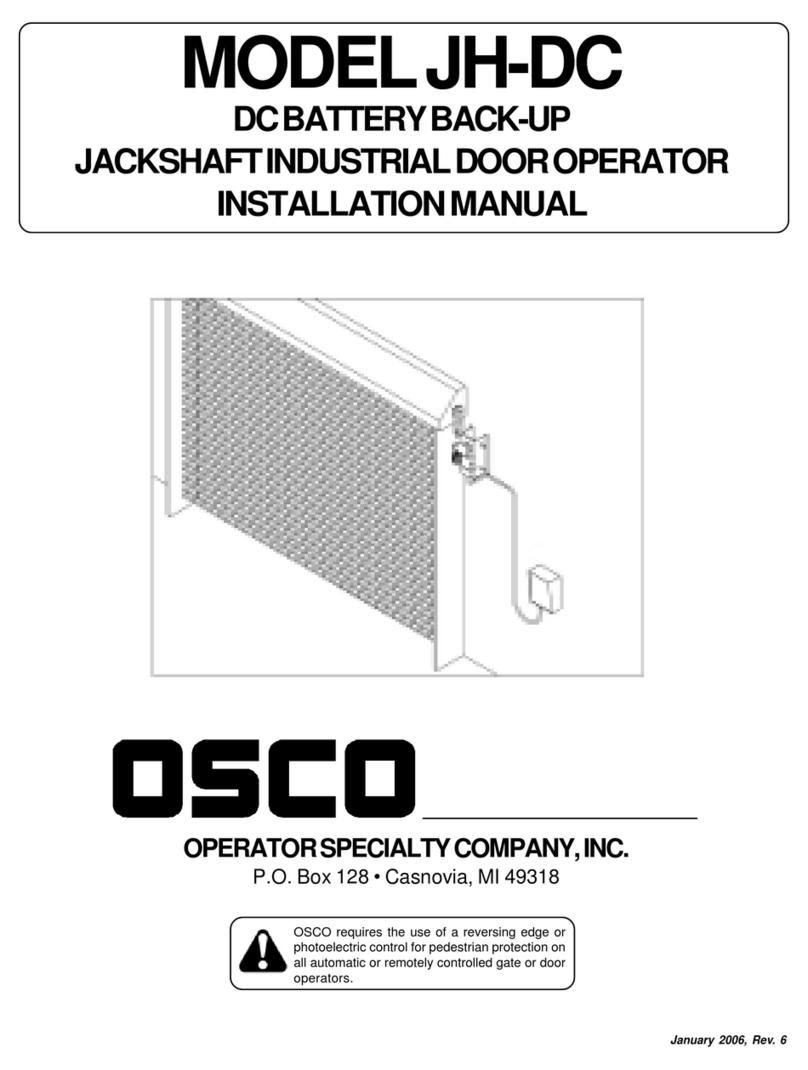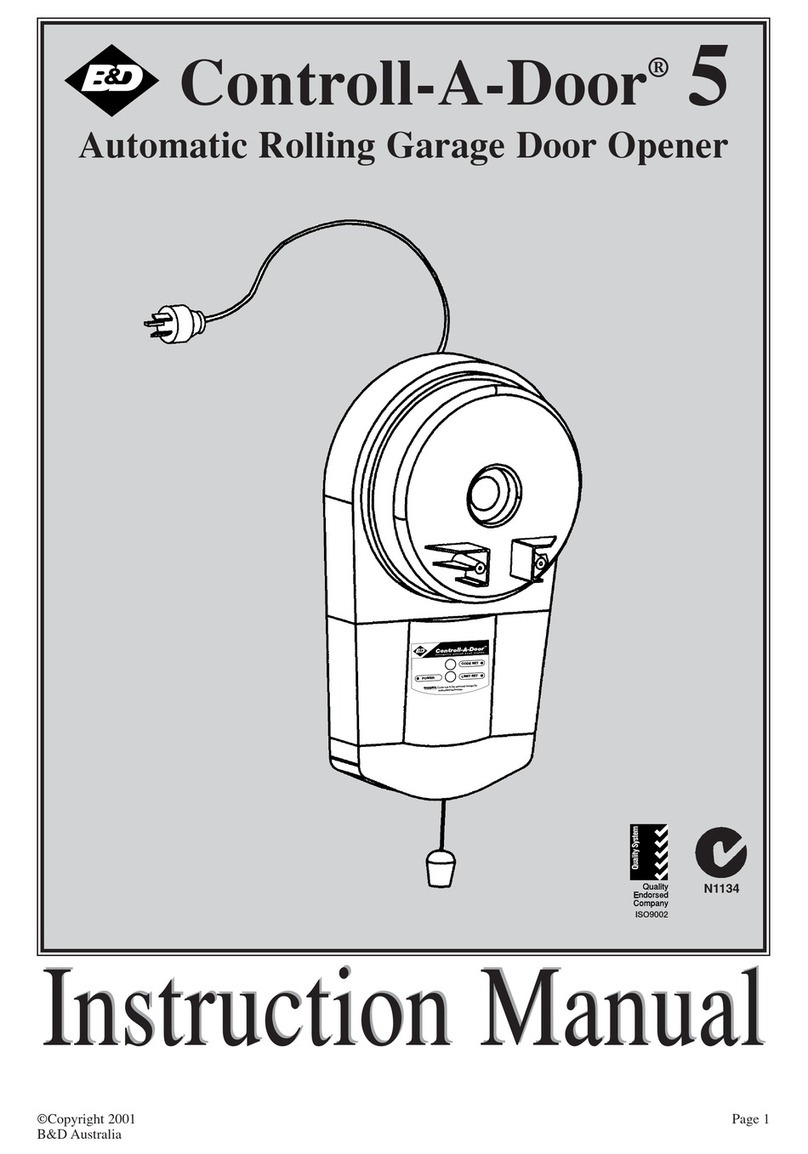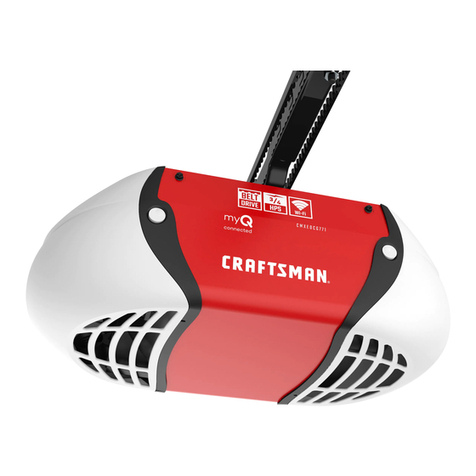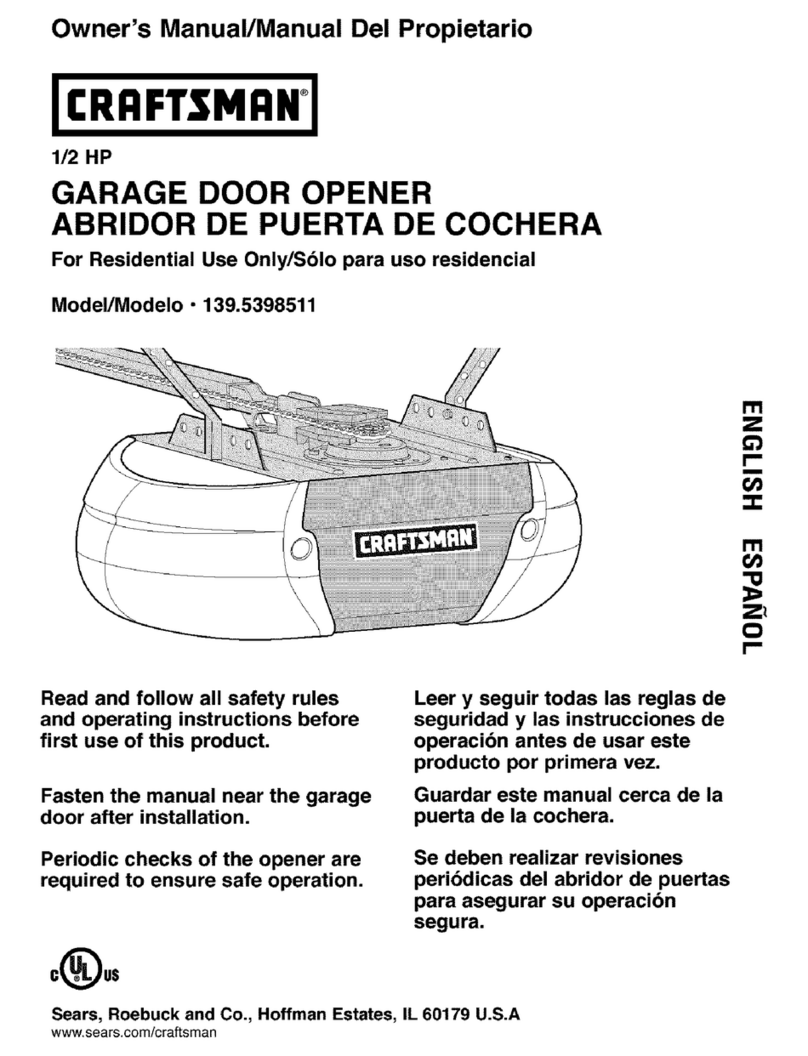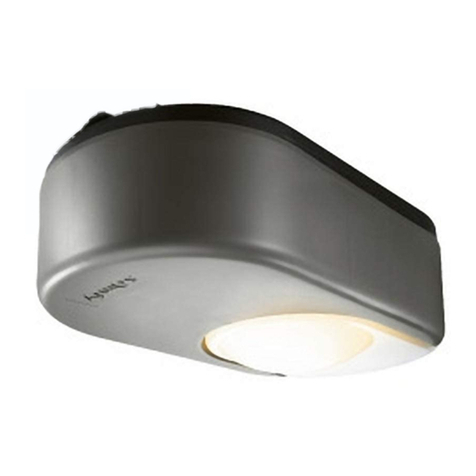OSCO Model T Setup guide

Model T
Medium-Duty Commercial
Drawbar Door Operator
Safety, Installation, and
Service Manual
OSCO requires the use of an electric edge or photoelectric
control for pedestrian protection on all automatic or
remotely controlled door operators.
OPERATOR SPECIALTY CO., INC.
P.O. BOX 128, CASNOVIA, MI 49318
11-14-97
032398

OSCO Model T Instructions Page 2
11-14-97
Safety Information and Warnings
Read all of the following before beginning to install the
Model T operator:
1. Read the green “SAFETY INSTRUCTIONS” sheet
provided with the operator information. It’s ex-
tremely important that the safety warnings and
precautions be understood and followed by the
installing contractor. Leave all instructions with
the end user.
2. Do not attempt to operate the machine unless it is
completely installed as instructed.
3. The installation must be made in a neat and
professional manner, observing all rules of good
workmanship and personal safety.
4. All electrical connections to the power supply must
be made by a qualified and licensed electrician.
All local and national codes must be observed.
5. A power-disconnect switch should be located
within sight of the operator so that primary power
can be turned off when necessary.
6. Do not remove the operator cover unless you are
qualified to service this equipment and the power
is turned off. There are no user-serviceable parts
inside.
7. Install enclosed warning signs so as to be visible
to all persons passing near or through the door.
8. Operate the door only when it is in full view.
9. Do not permit children to play on or around the
door.
10. Never reach through or around a door frame to
operate the door controls.
11. Install all recommended safety equipment.
Features
Mechanical
• 1/2 HP instant-reverse motor with capacitor and automatic
reset thermal overload
• Adjustable friction clutch
• Dependable roller chain drive
• Efficient V-belt reduction
• Emergency disconnect for manual operation
• Double-angle track—1 1/2” X 1 1/2” X 1/8”
• Door speed 0.8–0.9 feet per second
• 3” Headroom required above high rise of door
• Designed to operate doors up to 14” high
Electrical
• Easily adjustable rotary limit switches
• 24V control circuit
• External terminals for radio control, electric edge, photo-
electric device, or pushbutton station
• 3-Button control — OPEN–CLOSE–STOP
• Adapted for pull cord, radio control, or single button
control
CAUTION
OSCO STRONGLY RECOMMENDS USE OF AN
ELECTRIC EDGE OR PHOTOELECTRIC CONTROL
FOR PEDESTRIAN PROTECTION ON ALL AUTO-
MATIC OR REMOTELY CONTROLLED DOOR OP-
ERATORS.
Children should never be allowed to play on, near, or
around a motorized door. Any control devices should be
placed so as to be inaccessible to small children.
The door should never be operated unless it is in visual
sight of the user.
Warning signs must be installed on or near the door.
A pushbutton or keyswitch should not be installed within
reach of the door or operator.
LIMITEDONE-YEARWARRANTY
This electric operator is warranted for a period of one (1) full year from date of installation against defects in materials or
workmanship. Any part, parts, or complete unit which fails because of such defects within this period shall, at the
manufacturer’s option, be repaired or replaced at no charge. The manufacturer will not be responsible for transportation
and/or field service charges.
This warranty is in lieu of all other warranties, expressed or implied, and shall be considered void if visible evidence
implies recommended installation procedures and maintenance instructions were not followed.

OSCO Model T Instructions Page 3
11-14-97
Installation Instructions
Step 1: Operator Assembly
Secure the rails to the power unit using the 5/16” bolts
provided. Then slide the traveller onto the rails, making
sure that the chain connection is away from the power
unit and toward the front.
Attach the front idler assembly and shaft to the rails,
using the appropriate holes (as shown) and tighten
securely.
Unroll the chain in the direction of the chain idler, allowing
the chain to loop around the pulley. Continue unrolling the
chain and engage the sprocket at the power unit. Chain
should be pulled tight before engaging the sprocket, but
do not overtighten, as damage can result. Be sure the
chain is strung though the hole from the top.
Locate the traveller near the center and attach the chain.
Tighten the chain sufficiently to remove any slack but,
once again, do not overtighten, as damage can result.
Using the 5/16” hardware provided, attach the center rail
supports to the rails.
Step 2: Header Bracket Positioning
Locate the centerline of the door opening and draw a
light pencil line on the door header and on the upper
portion of the door. Then, by raising the door, determine
the “high rise” of the door. This is the highest point to
which the door will rise when the top section starts to go
over the radius of the track. Using lag bolts provided,
mount the front header bracket a minimum of one inch
above the high rise on the centerline of the opening.
Step 3: Operator Installation
Using two 5/16” bolts, attach the operator to the header
bracket.
Raise the power-unit end of the operator and open the
door fully. Support the operator 3–4 inches above the
door, using a ladder or other suitable substitute. Make
sure the operator is in line with the door centerline.
(Installation Instructions Cont’d on Page 4)
040501

OSCO Model T Instructions Page 4
11-14-97
Installation Instructions (Cont’d)
Step 3: Operator Installation (Cont’d)
Secure the operator to the ceiling or overhead truss,
ensuring stability and allowing the operator to rest above
the path of the door track.
Important: During door travel, the operator must be
a minumum of one inch above the door
and be properly aligned.
Normally, angle iron of 1” X 1” X 1/8” size is ample for
hanging the operator, provided sufficient rigidity can be
obtained by diagonal bracing.
On doors over 10 feet high, it is necessary to support
the center (approximately) of the rail with a hanger
dropped from the ceiling. Holes are provided in the rail
for this purpose.
Finally, manually close the door fully and secure the
door bracket on the door centerline directly in line with
the door rollers. For wood doors, use two carriage bolts.
For metal or fiberglass doors, use two 5/16” bolts.
Step 4: Electrical Connection
A complete electrical circuit print is included with the
operator information packet. The power supply must be of
correct voltage and phase and should be brought into the
operator with no smaller than No. 12 wire. For proper wire
gauge, refer to “Wiring Specifications,” on Page 10.
Electrical power must be ample and not taken from an
overloaded line, as faulty operation will result. Proper
thermal protection is supplied with the operator. The motor
contains a thermal overload protector to guard against
overheating due to overload conditions.
IMPORTANT
A. Power supply must be of correct voltage and
phase.
B. Always disconnect power from the operator
before servicing.
C. Keep clear of the door during operation.
IMPORTANTNOTICE
This operator is supplied with a 3-button control station
(OPEN–CLOSE–STOP) accompanied by a precautionary
sign:
It is vital that the 3-button station be mounted within sight
but out of reach of the door and that the warning sign be
mounted adjacent to the 3-button station.
The 3-button station must be connected so the STOP
circuit between terminals #2 & #4 is not bypassed.
Also, if additional 3-button stations are to be con-
nected, the STOP buttons must be wired in series.
NOTE: A STOP button must be used when the instal-
lation has radio controls or a single button.
Desired Function Connecting Terminals
OPENINGDEVICE #1 & #4
STOP #2 & #4
CLOSE #3 & #4
OPEN& CLOSE #4 & #5
SAFETYTOREVERSE #4 & #6
24VACPOWER #2 & #10
020200

OSCO Model T Instructions Page 5
11-14-97
LimitSwitchAdjustment
Limit switches are factory set for short travel. Travellers
should be at least two feet from either end of the rails
when the unit is assembled.
1. Disconnect the door from the traveller.
2. Turn the power on and push the OPEN or CLOSE
button. The traveller should move approximately two
feet.
3. Adjust the limit nuts (found in the electrical control
panel) by releasing the spring-loaded detent plate
and turning the nuts in the desired direction. One
complete turn will allow the traveller (or door) to
move approximately four inches.
IMPORTANT: LSO-2 and LSC-2 must be actuated
before LSO-1 and LSC-1. LSO-2
should be actuated three revolutions of
limit shaft before LSO-1.
4. Be sure the detent plate is properly locked into both
limit nuts when adjustment is complete.
NOTE: On 3-phase equipment, direction can be wrong.
If the door closes when the OPEN button is
pressed or vice versa, any two of three motor
leads must be reversed. DO NOT REVERSE
THE PUSHBUTTON LEADS.
TURN OFF POWER TO THE
OPERATOR BEFORE
MAKING ADJUSTMENTS!
Clutch and Cutoff Switch Adjustment
The clutch is set light at the factory and must be prop-
erly adjusted in the field for the size and weight of the
door. Adjust the clutch spring tension so the operator will
drive the door closed. It is best to start with a light
adjustment and tighten one-half turn at a time.
Lubrication
The operator bearings and motor are factory lubricated
for life. It may be advisable to oil the roller chain to
prevent excessive dryness or rusting under humid
conditions.
Manual Disconnect
For your safety and protection, this operator is provided
with a manual disconnect system. It is recommended
that all persons be well informed of its purpose and
operation.
To disconnect the operator, pull the disconnect cord as
shown. To re-engage the operator, pull the disconnect
cord down and manually connect the door arm to the
traveller.

OSCO Model T Instructions Page 6
11-14-97
Ordering Replacement Parts
Use the numbers shown in the lists on the following pages to order all replacement parts.
1. Supply the serial number of your operator.
2. Specify the quantity of pieces needed.
3. Order by part number and name of part.
4. State whether to ship by freight, truck, parcel post, UPS, or air express.
5. State whether transportation charges are to be prepaid or collect.
6. Specify name and address of person or company to whom parts are to be shipped.
7. Specify name and address of person or company to whom the invoice is to be sent.
Troubleshooting
Door will not operate from OPEN or CLOSE
pushbutton:
A. The motor overload kicked out. Wait 15 minutes; the
overload will automatically reset. Be sure the door is
not binding.
B. Check for a defective transformer.
C. Check for a defective STOP button or loose connec-
tion in the stop circuit.
Door will not open from OPEN button but will close
from CLOSE button:
A. Make sure the open limit switch is not hung up.
B. Check for loose wiring on the open limit switch or the
open relay coil.
C. Check for a defective open relay coil.
Door will not close from CLOSE but will open:
Same as preceding, but in reverse.
Door runs in wrong direction on 3 phase:
Reverse the two motor leads.
Door not closing properly:
Be sure the detent plate is properly engaging the
travelling limit nuts.
Motor runs but door doesn’t move:
A. Tighten the clutch.
B. Check the set screw in the motor pulley.
C. Check the V belt.
Operator vibrates and bows:
If the door is 10 feet or higher, be sure center support is
used.
Operator stops when you release button (makes
rocking noise):
The clutch spring is too loose. Tighten the clutch nuts.
Operator requires constant pressure on OPEN or
CLOSE button:
Check that the clutch sprocket is properly seated.

OSCO Model T Instructions Page 7
11-14-97

OSCO Model T Instructions Page 8
11-14-97
Ref.
No. Part No. Description
2110-264 Intermediate Shaft Assembly
2 2100-607 Shaft Bracket
3 2110-462 Intermediate Shaft with Sprocket
4 2200-286 Pulley, 6"
5 2200-029 Flange Bearing, 1/2" (2)
8 2200-193 E-Ring, 1/2"
56 2400-203 Wave Washer, 1/2"
45 2400-048 HHCS, 5/16”-18 x 3/4”
2110-299 Clutch and Output Shaft Assembly
7 2110-463 Clutch Shaft with Sprocket
10 2200-218 Drive Sprocket, 48 B 10, 5/8" Bore
11 2400-026 Spring Pin
12 2400-236 Solid Pin
13 2100-846 Clutch Hub
15 2100-564 Clutch Disc
16 2220-006 Clutch Sprocket, 48 B 30, with Hub
18 2200-367 Clutch Spring
19 2400-061 Clutch Hex Nut
20 2400-062 Clutch Jam Nut
59 2400-215 E-Ring, 5/8" (2)
60 2200-195 Flange Bearing, 5/8" (2)
26 2110-266 Idler Assembly
27 2400-144 Idler Shaft
28 2100-904 Idler Spacer
29 2400-090 Hex Nut, 1/2"-13
30 2400-196 Fender Washer, 1/2" ID x 2" OD (2)
32 2400-244 Flat Hardened Washer, 1/2"
33 2400-054 Lock Washer, 1/2"
1 2100-764 Operator Base
21 2200-039 #48 Clutch Chain, 21 Links
24 2200-453 #48 Rotary Chain, 19 Links
54 2200-008 Sprocket, 48 B 10, 1/2" Bore Tapped
6 2200-208 V-Belt, 26"
23 2200-132 Motor Pulley, 2"
43 2100-801 Header/Rail Support Bracket
22 2500-445 Motor, 1/2 HP, 115V, 1 Phase
Rail Pairs 1 1/2" x 1 1/2"
42 2100-634 10' 8" Long — for 8' Door
2100-635 12' 8" Long — for 10' Door
2100-636 14' 8" Long — for 12' Door
2100-638 16' 8" Long — for 14' Door
Ref.
No. Part No. Description
25 2520-135 Complete Controller Assembly
(WD #2600-110)
2120-061 Controller Enclosure with Cover
2100-687 Enclosure Cover only
2100-057 Limit Switch Shaft
2200-029 Flange Bearing, 1/2”
2100-056 Detent Plate
2200-028 Detent Spring
2100-060 Limit Switch Spacer
2200-030 Limit Nut
2500-113 Capacitor
2100-113 Capacitor Clamp
2500-030 Limit Switch (LSO-1, LSC-1)
2500-440 Limit Switch (LSO-2, LSC-2)
2500-541 Relay - CRC or CRO
2500-025 Transformer, 115/24V
2500-442 Terminal Strip 3
2500-439 Terminal Strip 4
58 2500-033 Standard 3-Button Station
40 2110-275 Complete Door Arm Assembly
2110-328 Upper Door Arm Assembly
2100-768 Lower L-Arm
41 2100-544 Door Bracket
34 2200-887 Traveler
2110-533 Chain Tension Bolt with Hex Nuts
38 2400-168 Chain Tension Bolt, 5/16”
48 2400-011 Hex Nut, 5/16”-18
44 2200-654 #48 Chain, per foot
49 2200-010 #48 Master Link
2400-001 S-Clip
#48 Drive Chain Assembly
(Chain, master link, chain bolt, nuts)
2110-486 22' — for 8' Door
2110-456 26' — for 10' Door
2110-457 30' — for 12' Door
2110-458 34' — for 14' Door
Model T
Parts List #130
OSCO Drawing #2120-222
040501

OSCO Model T Instructions Page 9
11-14-97

OSCO Model T Instructions Page 10
11-14-97
Control Wiring
Wire
Volts Max Distance (ft) Gauge
24V 250 14
350 12
For distances of more than 350 feet, a
long-distance interface is required.
USE COPPER WIRE ONLY
1. Select your wire gauge from the top chart below.
2. The distance shown in the chart is measured in feet from the operator to the power source. DO NOT
EXCEED THE MAXIMUM DISTANCE.
3. When large-gauge wire is used, a separate junction box (not supplied) may be needed for the operator
power connection.
4. Select the gauge for control wiring from the bottom chart. For distances of more than 350 feet, a long-
distance interface is required.
5. Wire run calculations are based on the National Electrical Code, Article 430, allowing 5 percent voltage
drop.
6. Supply voltage must be within 10 percent of the operator rating under load conditions (not applicable for
208V).
7. Connect power in accordance with local codes.
8. The wire tables are based on standard copper wire. Wire insulation must be suitable to the application.
Wiring Specifications
Power Wiring
Volts Wire
& HP Max Distance (ft) Gauge
115V 281 12
448 10
713 8
1/2HP 1133 6
1802 4
Other OSCO Garage Door Opener manuals
Popular Garage Door Opener manuals by other brands
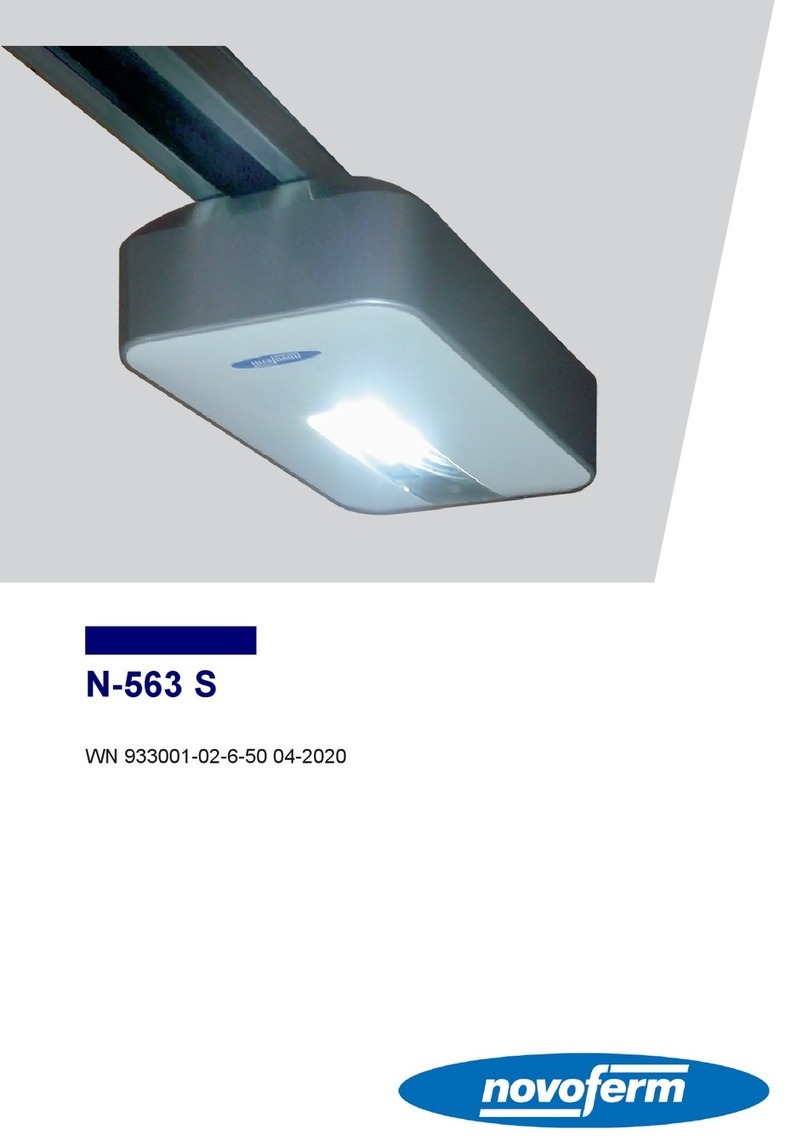
Novoferm
Novoferm N-563 S manual

ACDC
ACDC RAPTOR Installation instructions and user guide

Meccanica Fadini
Meccanica Fadini Elpro 220 instructions

ForceDoor
ForceDoor FS 600 Installation instructions and user guide
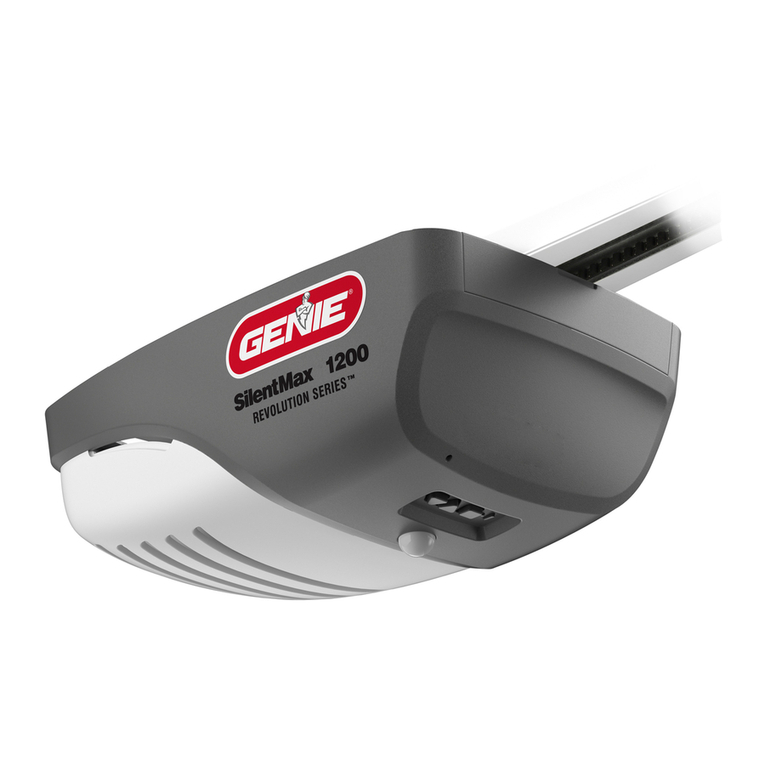
Genie
Genie CHAINMAX 1200 4022 Operation and maintenance manual
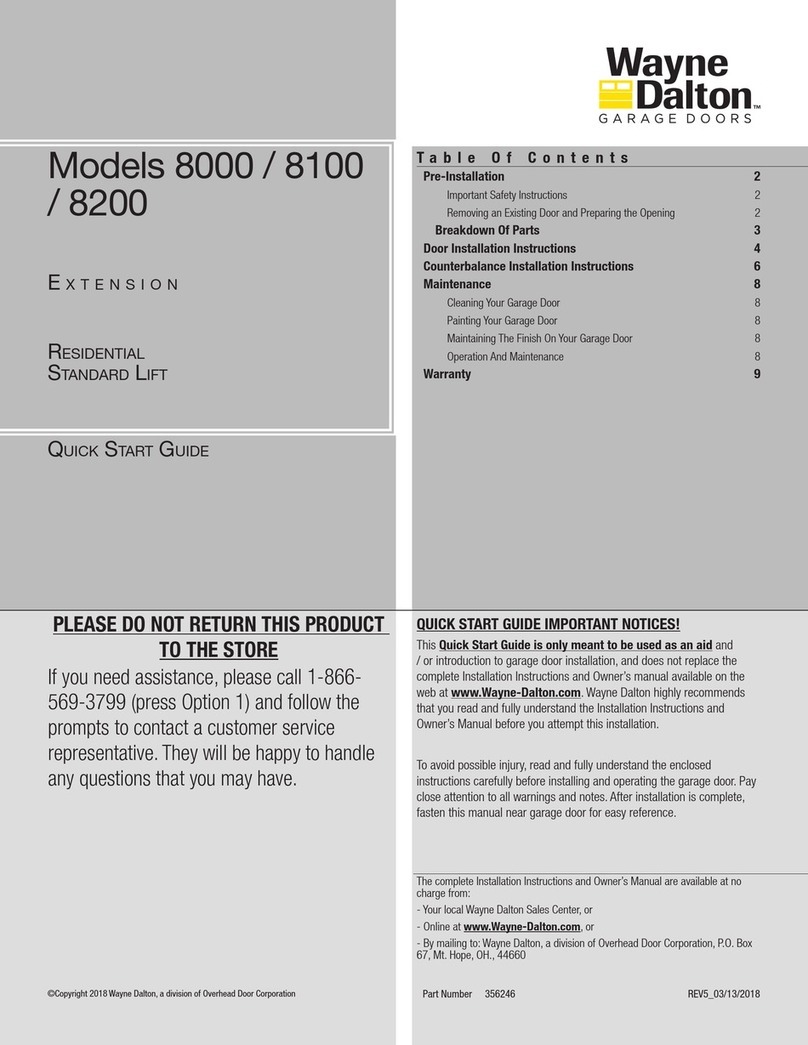
Wayne-Dalton
Wayne-Dalton 8000 Series quick start guide
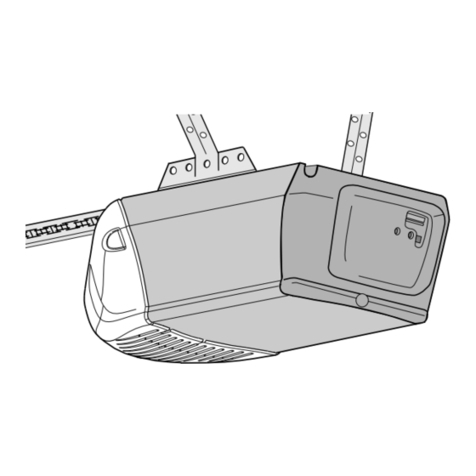
Raynor
Raynor Navigator 2245RGD owner's manual
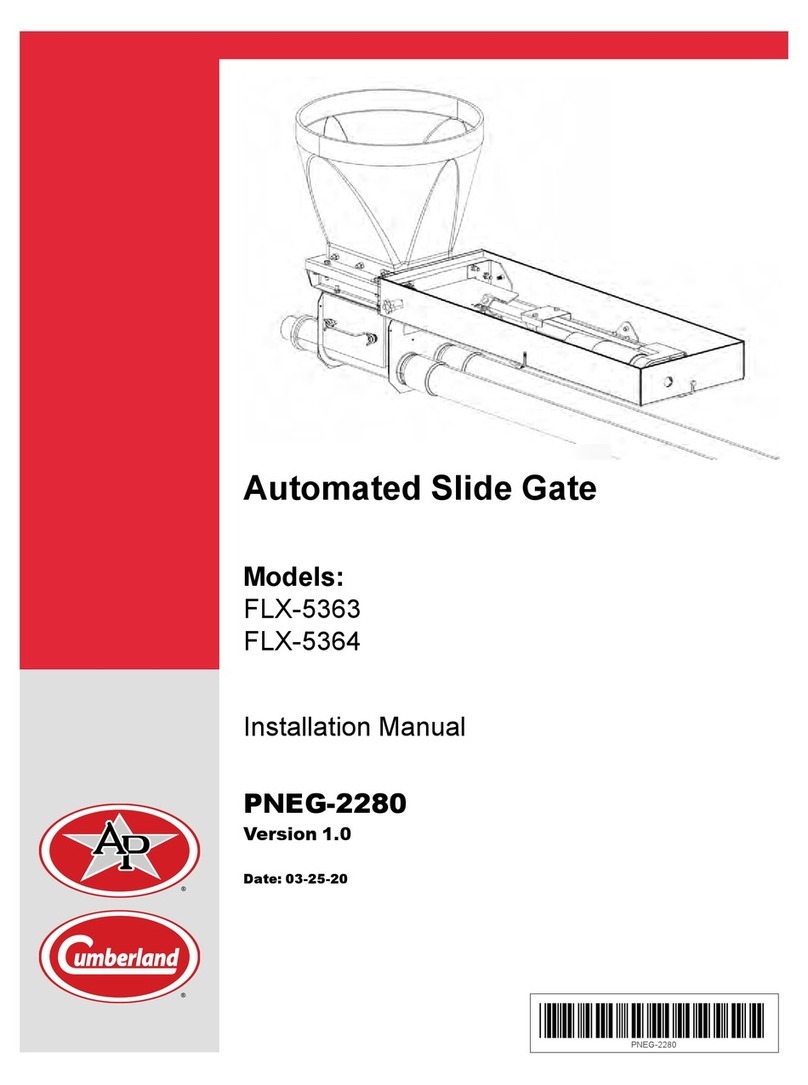
Cumberland
Cumberland FLX-5363 installation manual
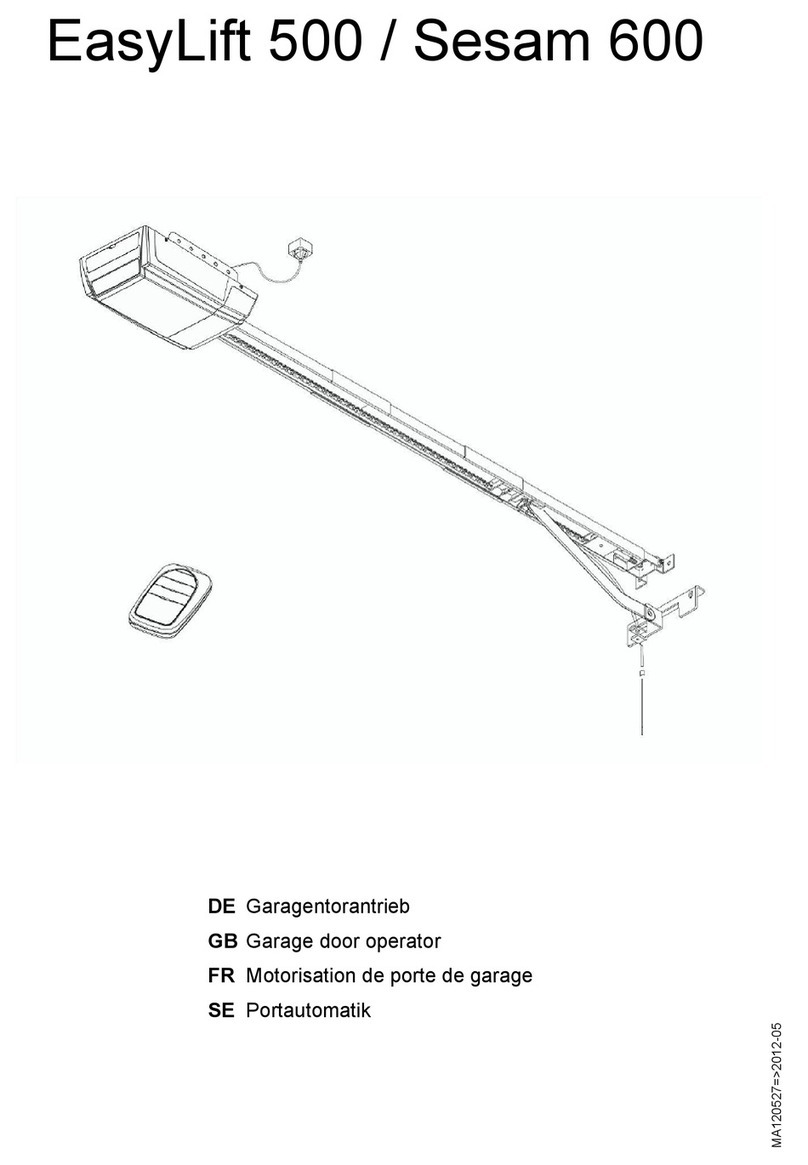
Normstahl
Normstahl EasyLift 500 Translation of the original operating manual
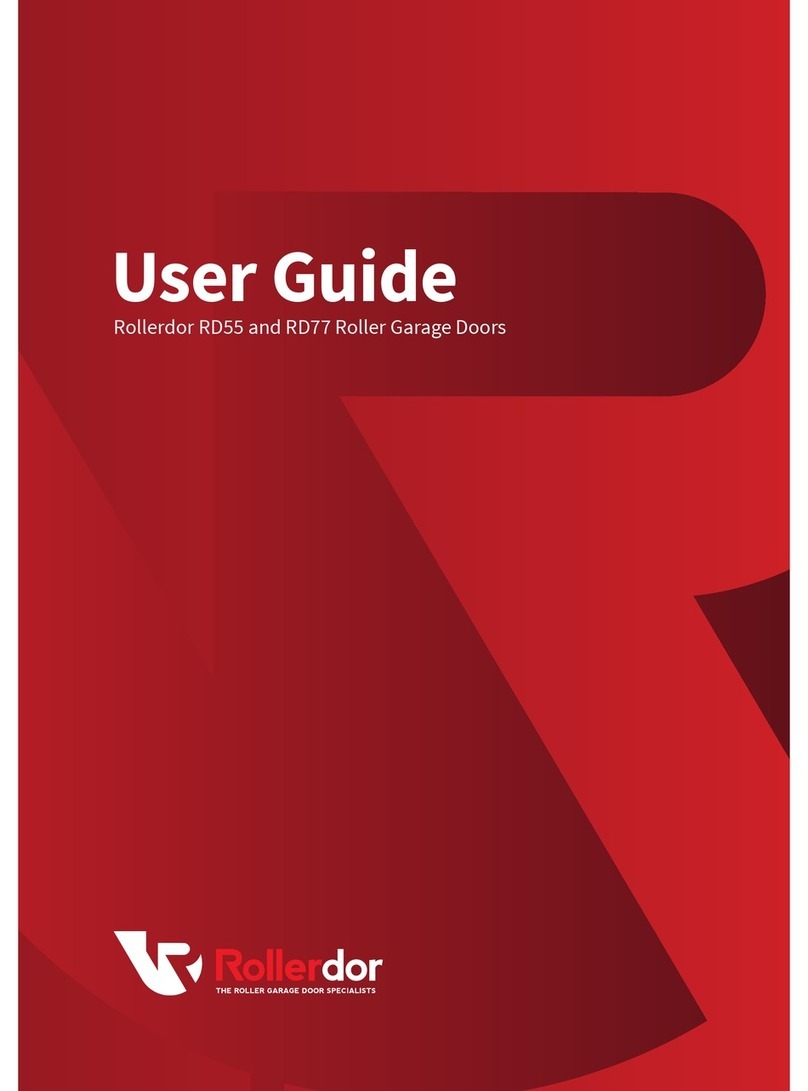
Rollerdor
Rollerdor RD55 user guide
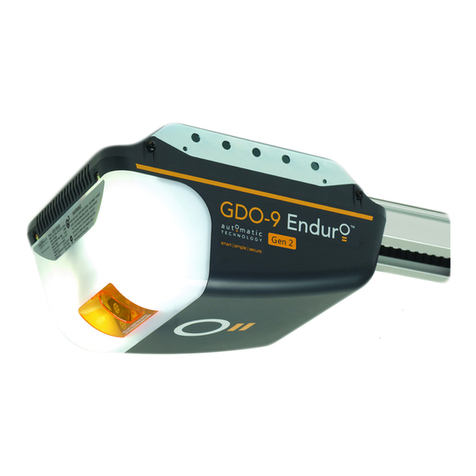
Automatic Technology
Automatic Technology GDO-9v2 Enduro Gen 2 installation instructions
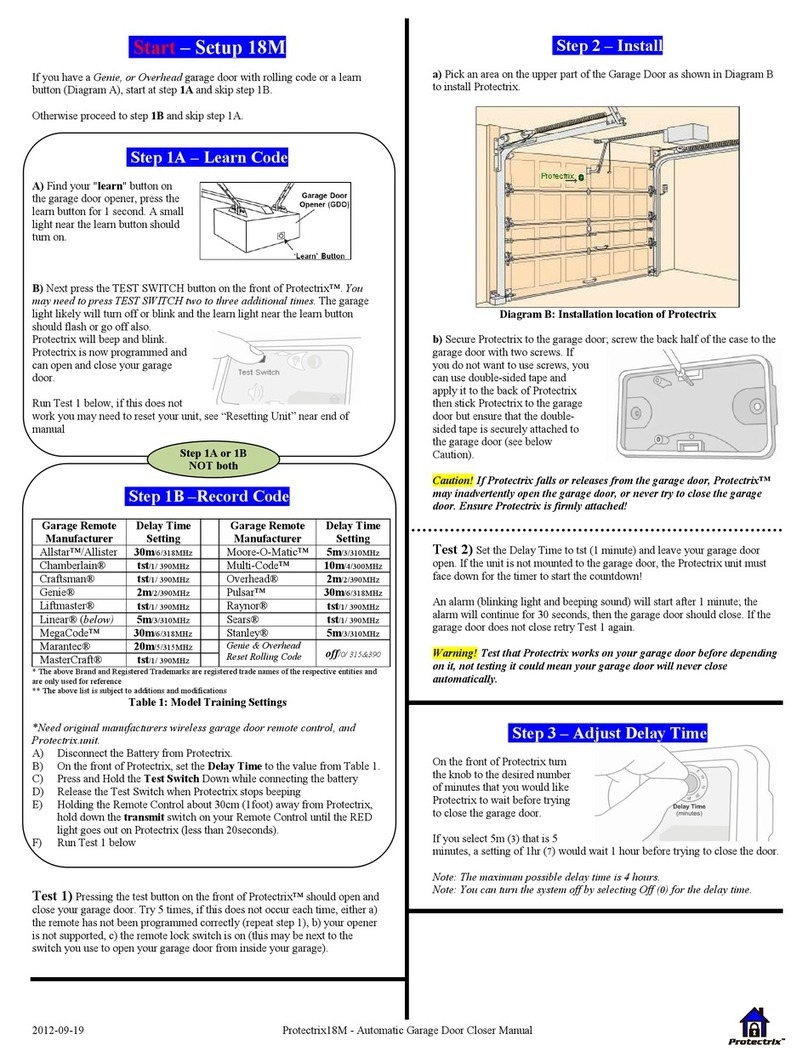
Genie
Genie Protectrix18M Manual guide
